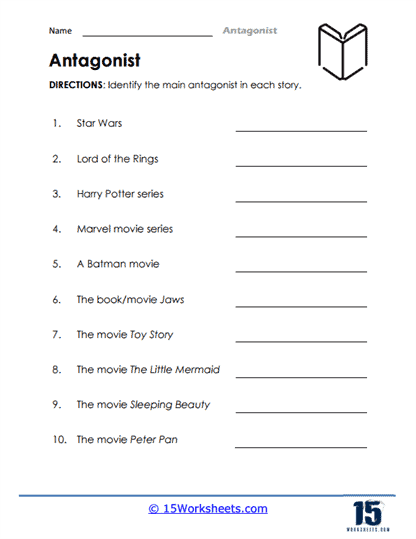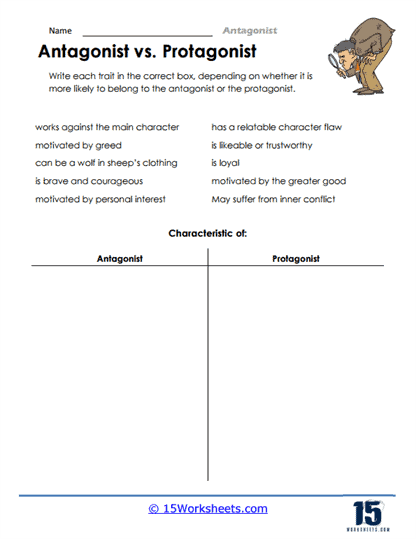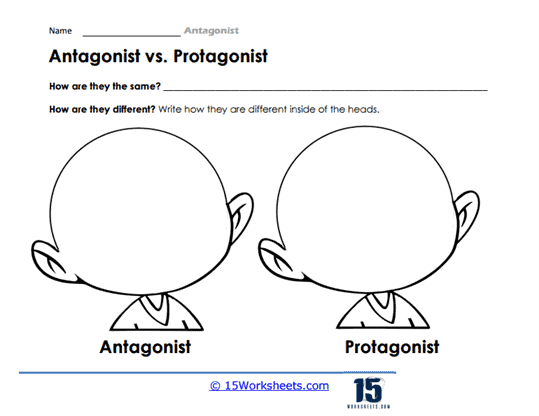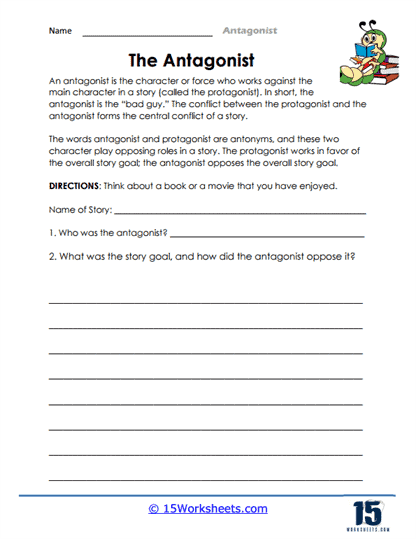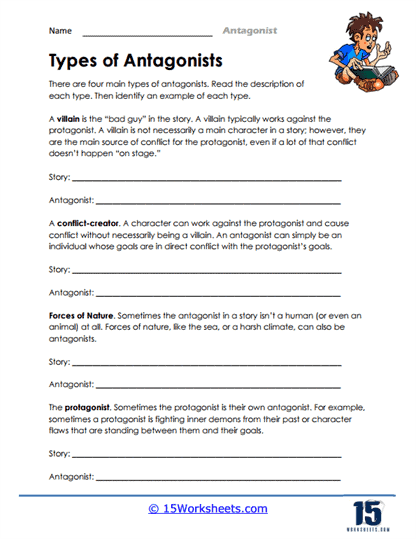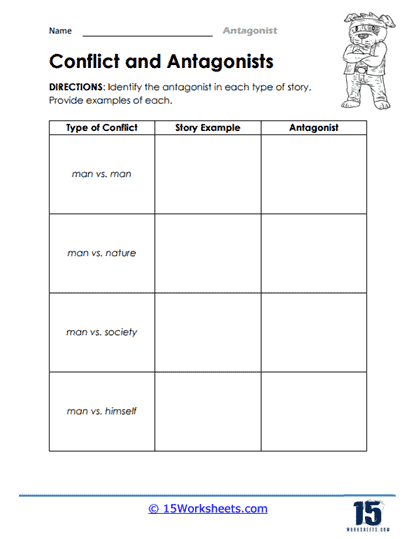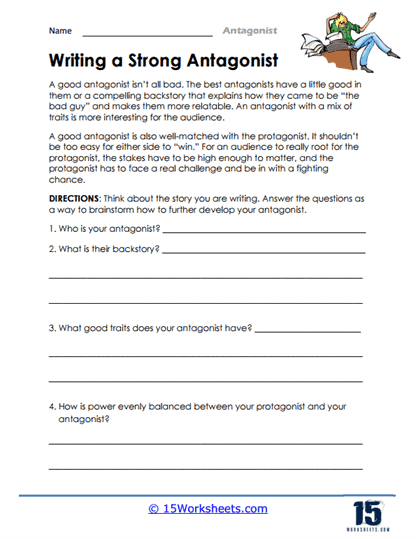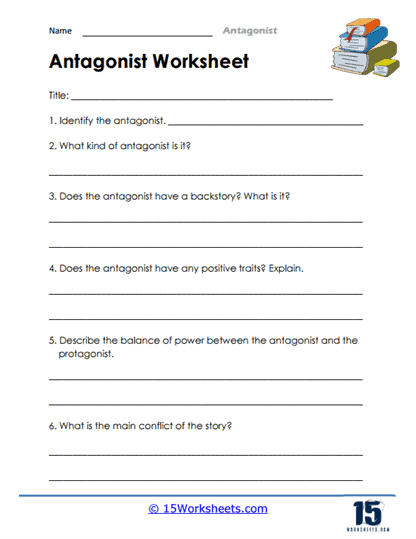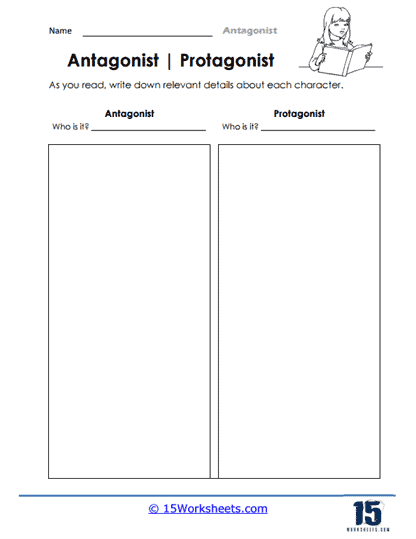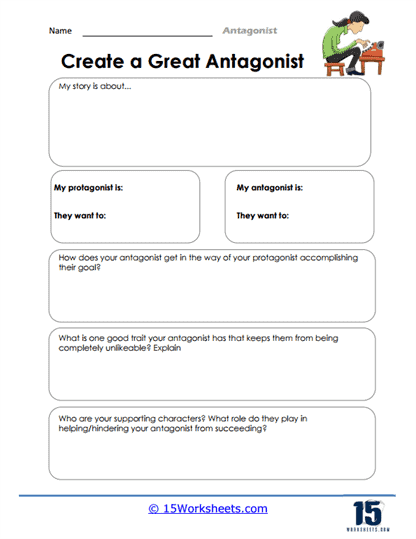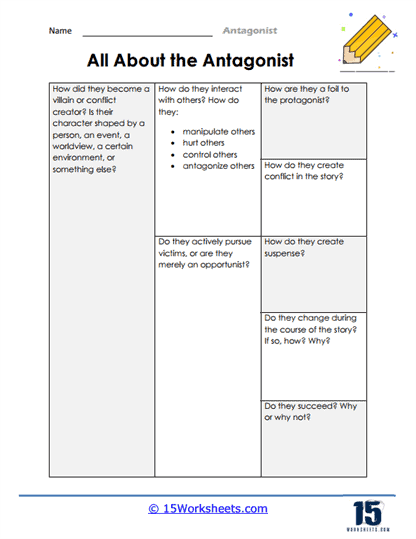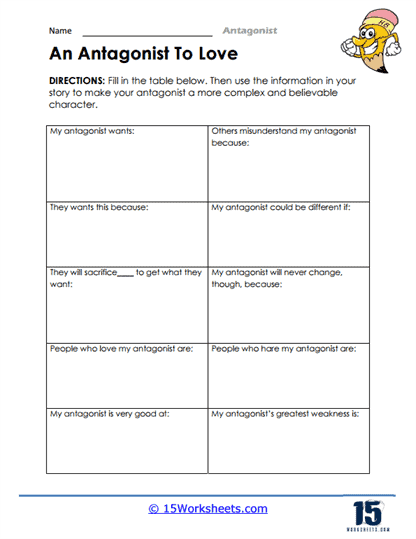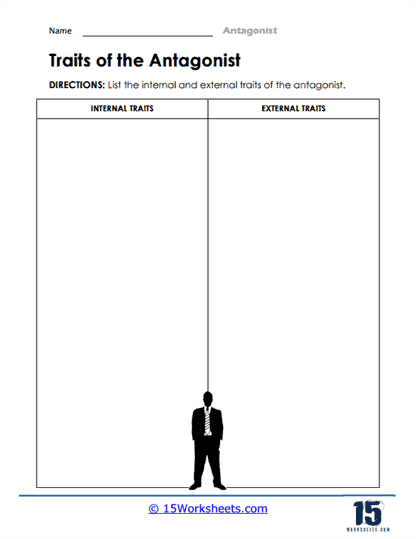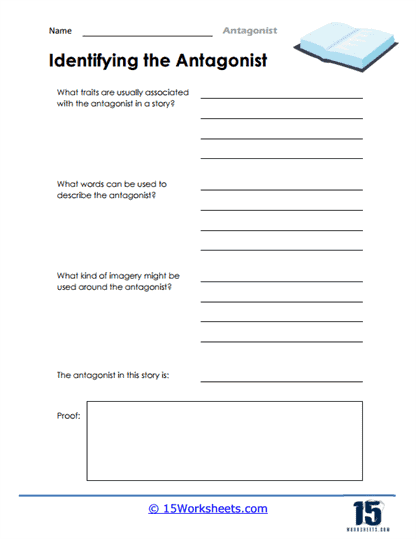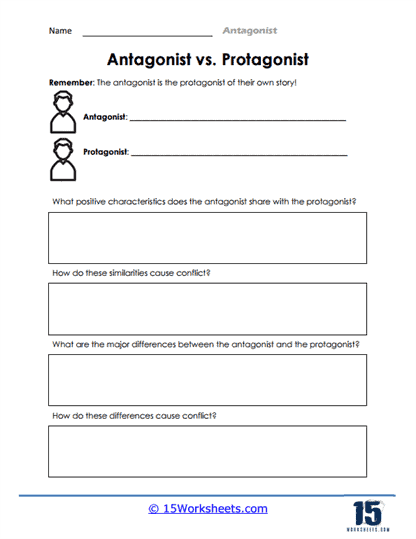Antagonists Worksheets
All About These 15 Worksheets
Antagonists, the characters or forces that oppose the protagonist in a story, play a crucial role in literature and storytelling. Understanding antagonists goes beyond recognizing them as mere villains; it involves exploring their motives, complexities, and their contribution to the narrative. Proficiency in analyzing and appreciating antagonists not only enhances a student’s literary comprehension but also nurtures critical thinking and empathy.
In a world where the ability to understand differing perspectives is invaluable, students must develop the skills to recognize and engage with antagonists effectively. To empower students with the ability to dissect, understand, and appreciate antagonists, we proudly present a collection of 15 worksheets on Antagonists. These worksheets are meticulously designed to provide students with structured and engaging opportunities to explore, analyze, and gain insights into the world of antagonists in literature.
How Do These Worksheets Help Students?
These worksheets will help you explore and understand the role of the antagonist in a story. The antagonist is the character, group of characters, or force that opposes the main character, also known as the protagonist.
In these worksheets, you will encounter various activities and questions that encourage you to examine the antagonist’s traits, motivations, and actions. You might analyze how the antagonist creates obstacles and conflicts for the protagonist, and how they contribute to the overall plot development. The worksheets may also involve identifying different types of antagonists and their impact on the story.
The purpose of the worksheets is to develop your analytical and critical thinking skills. By studying the antagonist, you can gain insights into the complexities of characters and their relationships within a narrative. Understanding the antagonist’s role helps you appreciate the challenges and growth experienced by the protagonist, and it adds depth and excitement to the story.
Why Do Authors Use Antagonist As A Literary Device?
Authors use antagonists as a literary device for several reasons. Here are five examples:
Creating Conflict and Tension
Antagonists serve as a source of conflict in a story, providing obstacles and challenges for the protagonist. By presenting an opposing force, authors can create tension and suspense that keep readers engaged. For instance, in J.K. Rowling’s “Harry Potter” series, Lord Voldemort acts as the main antagonist, constantly challenging and threatening the protagonist, Harry Potter.
Developing Character Growth
Antagonists contribute to the development and growth of the protagonist. Through their opposition, protagonists face trials and must overcome obstacles, allowing their strengths, values, and convictions to be tested and developed. In Charles Dickens’ novel “A Christmas Carol,” Ebenezer Scrooge’s transformation is facilitated by the antagonist-like presence of the spirits who confront him with his past, present, and future.
Offering Contrast and Depth
Antagonists provide a contrasting element to the protagonist, highlighting their virtues, flaws, or differing perspectives. By juxtaposing these characters, authors can delve deeper into their themes and ideas. In F. Scott Fitzgerald’s “The Great Gatsby,” Jay Gatsby represents the protagonist’s pursuit of the American Dream, while Tom Buchanan acts as an antagonist, embodying the corruption and materialism of the era.
Enhancing Narrative Structure
Antagonists contribute to the overall structure and pacing of a story. They often act as catalysts for the protagonist’s actions and decisions, driving the plot forward. In J.R.R. Tolkien’s “The Lord of the Rings,” the antagonist Sauron’s pursuit of the One Ring propels the protagonist Frodo Baggins on his epic quest to destroy it, leading to the climactic resolution.
Reflecting Real-World Challenges
Antagonists can represent real-world challenges, conflicts, or societal issues. By embodying these challenges within a character or force, authors can provide commentary or criticism on these aspects of the world. In George Orwell’s “1984,” the totalitarian regime of Big Brother acts as the antagonist, representing the oppressive and controlling nature of certain political systems.
What Are The Different Types Of Antagonists?
Human
This type of antagonist is a character who directly opposes the protagonist. They may have conflicting goals, values, or motivations, and their actions create obstacles for the protagonist to overcome. Examples include villains, rivals, or enemies like Lord Voldemort in the “Harry Potter” series.
Supernatural
Supernatural antagonists are entities or forces beyond the realm of normal human experience. They possess extraordinary powers or characteristics that challenge the protagonist. Examples include mythical creatures, monsters, or supernatural beings like Smaug in “The Hobbit.”
Environmental
An environmental antagonist refers to a natural or environmental obstacle that hinders the protagonist’s progress. It can be a harsh climate, treacherous terrain, or dangerous wildlife. For example, the treacherous wilderness in Jack London’s “The Call of the Wild” serves as an environmental antagonist for the protagonist, Buck.
Internal
Sometimes, the antagonist is internal, residing within the protagonist themselves. This could be a personal struggle, inner conflict, or a flaw that the protagonist must overcome. In Robert Louis Stevenson’s “Dr. Jekyll and Mr. Hyde,” the internal battle between the two personas of the same character creates the internal antagonist.
Society or Institution
Antagonists can also be represented by societal structures or institutions that oppose the protagonist’s values or desires. It could be an oppressive government, corrupt organization, or unjust social norms. For instance, in George Orwell’s “Animal Farm,” the oppressive regime of the pigs serves as an antagonist to the animal characters seeking equality.
Fate or Destiny
Fate or destiny can be personified as an antagonist that presents unchangeable or predetermined challenges for the protagonist. This type of antagonist often represents larger themes such as the inevitability of certain events or the struggle against one’s predetermined path. The concept of fate is prominent in ancient Greek tragedies like Sophocles’ “Oedipus Rex.”
The Importance of Understanding Antagonists
Understanding antagonists and their various forms is of great importance for several reasons:
- Literary Appreciation: Proficiency in recognizing and analyzing antagonists enhances a student’s appreciation of literature by diving into the complexities of character development and plot dynamics.
- Critical Thinking: Analyzing antagonists encourages students to think critically about motivations, conflicts, and the moral dimensions of storytelling.
- Empathy and Perspective-Taking: Engaging with antagonists allows students to explore differing perspectives and foster empathy by understanding the reasons behind their actions.
- Narrative Analysis: An understanding of antagonists deepens one’s ability to analyze narratives, identify themes, and appreciate the art of storytelling.
This collection of Antagonists worksheets is a valuable resource for educators and parents committed to nurturing literary comprehension, critical thinking, and empathy in students. Proficiency in recognizing, analyzing, and appreciating antagonists equips individuals with the tools to engage with literature on a deeper level, understand differing perspectives, and appreciate the complexities of character development in storytelling.
This collection is an investment in their future success, ensuring they have the skills to excel academically and thrive as thoughtful readers and writers. Embrace these worksheets and watch your students embark on a journey of literary exploration and character understanding.

